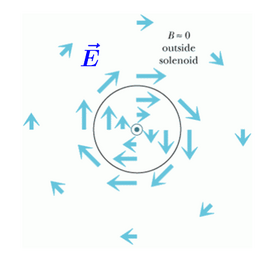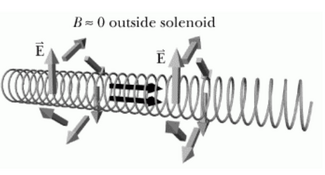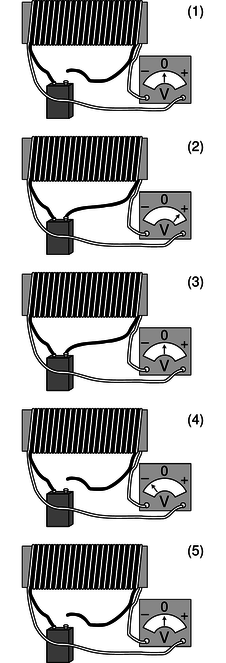Curly Electric Fields: Difference between revisions
No edit summary |
|||
| Line 39: | Line 39: | ||
The curly electric field has a standard effect on charges <math> ( \vec{F} = q\vec{E} ) </math> | The curly electric field has a standard effect on charges <math> ( \vec{F} = q\vec{E} ) </math> | ||
Because the curly electric field deals with non-stationary charges and the magnetic field and current are time-variant, the curly electric field is a '''Non-Coloumb Electric Field'''. | |||
===Direction of Curly Electric Field=== | |||
====Faraday's Experiment==== | |||
In 1831, [[Michael Faraday]] conducted an experiment which proved magnetic fields could be produced by electric currents. The experiment involved connecting a battery to a large coiled wire, and measuring the effects with a voltmeter. Faraday recorded effects both upon first connecting the battery and when initially disconnecting it the later of which was found surprising. | |||
[[File:faraday.png|400px|thumb|right|''The setup and observations from Faraday's experiment.'']] | |||
Because an effect could only be gauged when the magnetic field was changing, it was concluded that this effect was proportional to <math> ( \frac{\delta B}{\delta t} ) </math> | |||
Revision as of 10:35, 2 December 2015
This topic is claimed by Miranda Fyfe.
Curly Electric Fields
In the case where current in a solenoid is constant and magnetic force is likewise constant in time, it can be observed that the magnetic and electric forces experienced by some moving charge outside the solenoid are essentially zero.
However, in the situation where current in the solenoid is changing and magnetic force is thereby time-varying, a curly electric field can be observed.


Proportionality
This electric field is proportional to the rate of change of the magnetic field (dB/dt).
Inside the solenoid
Curly electric field is proportional to distance from the solenoid axis, r.
Outside the solenoid
Curly electric field is proportional to 1/r, with the field decreasing as distance from the axis increases.
The Non-Coulomb Curly Electric Field
Read more about the Non-Coulomb Electric Field
Coulomb Electric Field
Any electric field in accordance with Coulomb's law is said to be a Coulomb electric field.
Coulomb's Law: [math]\displaystyle{ \vec{E} = \frac{1}{4{\pi}{{\epsilon}_0}} \frac{q}{r^2} \hat{r} }[/math]
Non-Coulomb Electric Field
An electric field associated with a time-varying magnetic field, i.e. the curly electric field.
Effect on charges
The curly electric field has a standard effect on charges [math]\displaystyle{ ( \vec{F} = q\vec{E} ) }[/math]
Because the curly electric field deals with non-stationary charges and the magnetic field and current are time-variant, the curly electric field is a Non-Coloumb Electric Field.
Direction of Curly Electric Field
Faraday's Experiment
In 1831, Michael Faraday conducted an experiment which proved magnetic fields could be produced by electric currents. The experiment involved connecting a battery to a large coiled wire, and measuring the effects with a voltmeter. Faraday recorded effects both upon first connecting the battery and when initially disconnecting it the later of which was found surprising.

Because an effect could only be gauged when the magnetic field was changing, it was concluded that this effect was proportional to [math]\displaystyle{ ( \frac{\delta B}{\delta t} ) }[/math]